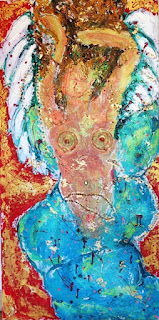 |
| deerapposelli.com |

Sirens were creatures that were half-bird,
half-woman, in origin, perhaps like the Egyptian ba. To the ancient Egyptians, the ba was the surviving part of a person that flew to the Underworld
when a person died, but sirens were renegade creatures. According to classical
myth, they lived on treacherously rocky isles off the coast of Sicily. They
wanted nothing more than to entice passing sailors. Being lured, these sailors,
thinking they’d get good head, instead found themselves in listless,
dumbfounded stupors from which they languished and died.
It was portended that if a ship passed in
which the occupants were resistant to the sirens’ song, the sirens, in frenzied
dismay, would kill themselves. Thus, it is told in the Odyssey that these creatures leaped off cliffs when the epic’s
hero, Odysseus, and his crew sailed by.
The sirens descended to the Underworld where
they continued to sing, this time in mourning for the dead. Their imagery became
mixed up with that of mermaids who themselves, in lore, were the mystical
remnants of disposed-of women. Taking vengeance on the violence done to them, mermaids,
thus, lured men to their deaths with the promise of sex through the sweetness
of their song.
It all meant something metaphorical about
men, women, ecstasy, sense control, and, of course, sex and death. One had to
ponder it and trace the meme across cultures and time. To say that Aisa Morae
was a siren—or a fairy—a banshee or strix—was mere convention. No one knew what
she really was except that she was something of a Pandora’s box that had a thin
layer of jewels at the top under which scorpions rustled.
But it could be argued that, since Aisa Morae
was more a magical entity than a person, she
was actually a “thought-form.” That
is, she was really something that someone had magically thought up in such a
way that the thought took on form and came to life.
Thought-form‒like beings could linger
indefinitely, although they might become increasingly unstable over time. Aisa conceivably could go on for lifetimes,
becoming increasingly fouler and more erratic. It all depended on the prowess
of whoever had set her in motion in the first place. . .
The burning question for Michael was whether
Aisa Morae was ensouled or whether she was more of a phantasm. If she were
ensouled, disposing of her would be a criminal act. If she were a
thought-form—that is, a mirage of the imagination—especially if she were a
troublesome one—then making her go away might be a good deed.

No comments:
Post a Comment
Note: Only a member of this blog may post a comment.